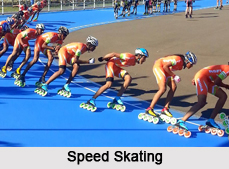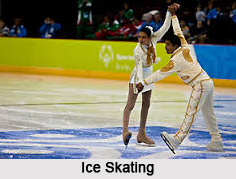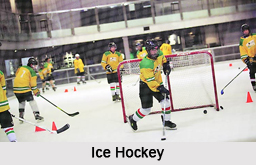 Skating can be divided into various categories. The skating is practiced in many parts of India like Uttar Pradesh, Uttarkhand, Kolkata, West Bengal, Himachal Pradesh and Jammu and Kashmir. Some of the categories are discussed below:
Skating can be divided into various categories. The skating is practiced in many parts of India like Uttar Pradesh, Uttarkhand, Kolkata, West Bengal, Himachal Pradesh and Jammu and Kashmir. Some of the categories are discussed below:
Speed Skating
Speed skating is always performed in open air. International championship meets are normally of two days duration. On the first day 500 m and 5000 m events are held and on the second day 1500 m and 10000 m. The best all round performers over these four distances, calculated on point basis, is declared the overall champion. Ice speed skating record holders are the fastest self-propelled human beings over land. They can exceed 30kmph.
Skates and Boots for Speed Skating
Speed skating skates are comparably longer than figure skating skates. The blades are as thin as 1/32 in (0.794 mm) reinforced with steel tubing for lightness and Strength. These are usually 12 to 18 in long and designed to travel in a straight line. The boots for speed skating are lighter in weight than those for figure skating. These are made of thin leather and have longer heel supports
Figure Skating
In senior championships, solo competitors are required to skate three specific ice skating figures, followed by a short programme of prescribed free skating elements and finally a freestyle performance accompanied by music lasting five minutes for men and four minutes for women. Pair skaters perform a series of prescribed free skating movements followed by a self-devised freestyle performance. Out of the 41 figures officially recognised by the ISO, there are some best known. Each figure skates three times. When a skater completes a figure the judges examine the pattern left by the skates. A bulge in a circle or a flattening of the skate or an improper change from one blade edge can be counted against the competitor. The position of hand, fingers and non-skating foot are also taken into consideration. Points up to six are awarded for each figure. These marks are subsequently multiplied by a factor of one and six according to the recognised standard of the figure.
Skates and Boots for Figure Skating
 The skate blade for figure skating is very slightly curved from heel to toe and is usually set on a 7 ft (2.13 m) radius. The under-part of the blade is not flat but has a hollow ridge right along the centre. The sides of the hollow ridge are called the edges of the skate. The blade is about 1/8 in wide and slightly longer than the length of the boot. Men use black leather boots whereas women use boots of white suede. The boots have strong support reinforced with a stiffening material around the heel and under the arch which prevents the foot from slipping to the side. Boots should not be larger but must fit tightly.
The skate blade for figure skating is very slightly curved from heel to toe and is usually set on a 7 ft (2.13 m) radius. The under-part of the blade is not flat but has a hollow ridge right along the centre. The sides of the hollow ridge are called the edges of the skate. The blade is about 1/8 in wide and slightly longer than the length of the boot. Men use black leather boots whereas women use boots of white suede. The boots have strong support reinforced with a stiffening material around the heel and under the arch which prevents the foot from slipping to the side. Boots should not be larger but must fit tightly.
Free Skating
Free skating is the climax of the competition. In this type of skating, intricate footwork is combined with jumps and spins, which are spaced between spirals and linking steps.
Some of the jumps are explained as:
1. Three-Jump: This comprises a half turn in mid-air, taking off from the forward outside edge of one skate and landing back on the outside edge of the other.
2. Loop Jump: This requires a full revolution in the air.
3. Spread Eagle Jump: A spread eagle jump is a two-footed glide in which the feet are positioned in line with each other, heels together and toes pointing outwards. Two turns frequently used are the "bracket", a half turn from one edge to the opposite edge of the same skate, with the body turning inside the circle, and the "counter", a half turn maintaining the same edge.
4. Flip Jump: This is a toe jump, and involves a take off from the back outside edge of the skating blade and rotating in mid air before landing.
5. Axel: This is a jump involving one and a half turns in the air named after its originator.
6. The Lutz: This is a jump in which the skater takes off from the back outside edge, helped by the toe point of the free foot rotating in mid air clockwise before landing on the back outside edge of the original foot.
7. The Salchow: This is a jump named after its originator.
8. The Split Jump: This is a toe jump in which the skater takes off from a back inside edge, half turns in mid air while swinging the legs up into a horizontal position and closes them before landing.
Spins in Skating
Some of the spins are explained below:
1. Single flat-foot spin is performed on the flat of the skate.
2. Sit spin starts as a standing spin. The skater immediately sinks on his knees with free leg extending in front.
3. Camel spin is a one foot spin holding the body and the non- skating leg in a horizontal position parallel to the ice.
4. Lay back spin is another one foot spin where the body is bent backwards, spinning parallel to the ice.
5. Cross foot spin is performed on the flat of both skate blades, with the legs in crossed position, toes together and heels apart.
6. Flying sit spin and flying camel, a jump variation of the camel spin.
 In ice skating competition- figure skating, the compulsory figures comprise 40 per cent of the total marks. In the prescribed free skating movements another 20 per cent and the skater freestyle performance comprises the remaining 40 per cent.
In ice skating competition- figure skating, the compulsory figures comprise 40 per cent of the total marks. In the prescribed free skating movements another 20 per cent and the skater freestyle performance comprises the remaining 40 per cent.
Pair Skating
Pair skating is divided into compulsory and freestyle sections. In the compulsory section, the pair is required to demonstrate six specified sequences. In the freestyle section, the two partners must perform movements giving a homogeneous impression and must fill the rink during a display. The following are the best known pair skating movements:
1. Death Spiral: The man swings his partner at a great speed.
2. The Single Lane Lift: The woman is lifted overhead in an outside forward take off.
3. The Axel Lift: The woman is turned one and a half times completely over her partner`s head.
4. The Split Lutz Lift: The woman is lifted from an outside back edge.
5. The Catch Waist Camel Spin: This is performed with the free leg pointing in the opposite direction
Ice Dancing
There is a great difference between pair skating and ice dancing. In ice dancing lifts are not permitted. F dancing consists of a non-repetitive performance (novel movements. Certain free skating movements which are in keeping with the character of the dances are allowed. However, the following limitations are imposed on the pair:
1. Separation of partners must not exceed the time necessary to change position.
2. Pivots must not exceed in duration. Spins must not exceed one and a half revolution.
3. Maintenance of one position should not be prolonged. A few movements of ice dancing are explained below:
(a) The Chasse: This is a sequence in which the free foot, during the process of becoming the skating foot, should not pass the original skating foot.
(b) Choctaw: A turn from forward to backward or vice versa.
(c) Mohawk: A half turns from forward to backward or vice versa.
(d) Twizzle: A rotation through a complete revolution performed rapidly to take place on one spot. European
(e)Waltz: This is the most popular of all the ice dances.
(f) Fourteen-Step Dance: The fourteen-step dance with a lively military style tempo is also popular.
(g) American Waltz: A series of half circles or lobes are skated along each side of the rink and joined at the ends by six best outside edges. Apart from the above, Foxtrot, Popular Blues, Argentine Tango, Rocker Foxtrot, Rumba Silver Samba, Vieanese Waltz, West Waltz and Starlight Waltz are also popular and pleasing to the eye. Championships are in two phases-Compulsory dances and Freestyle, each carrying half of the total marks.




